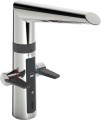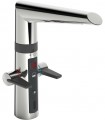The functions of a mixer mainly consist of design features, among which are the presence of a
check valve, a
pop-up waste,
cold start,
LED lighting, a
temperature control lever, a
display,
auto-drain (hygienic rinse), a
switch for washing machine/dishwasher, and a
shelf for accessories. More details:
— Check valve. A check valve prevents water from moving backward through the mixer, for example, when there is a significant pressure difference between hot and cold water. This feature is relevant for those planning to install water meters: the presence of check valves on mixers is often a mandatory condition for installation requests, as such valves prevent meters from running backward. Additionally, it's worth noting the presence of a check valve in the mixer (especially single-lever ones, see "Mixer Type") if your home's water supply is prone to interruptions — such mixers perform much better during pressure surges in the plumbing.
— Pop-up waste. A device that allows you to close the drain hole in a sink, kitchen sink, or bidet (depending on the purpose of the mixer). It comes in two types:
— Lever pop-up waste. This type of valve is operated by a small
...lever located behind the mixer, to the side, or at the front of the body. Raising and lowering it opens and closes the sink's drain plug.
— Push-button pop-up waste. Valves of this type are locked and unlocked by pressing the drain hole plug, which requires wetting your hand.
— Cold start. A feature found exclusively in single-lever models. The general principle of "cold start" is as follows: if you open the mixer with the joystick in the central (default) position, only cold water will flow out, not mixed warm water (as in more traditional single-lever devices). To add hot water and increase the temperature, you need to move the lever from the default position. This operation format can provide noticeable savings: by default, cold water flows from the mixer, and hot water is added only as needed.
— LED lighting. A lighting system based on LEDs — an efficient and economical light source. The purpose and functionality of such lighting can vary. In some models, it is installed on the spout and directed downward, allowing you to see the space under the mixer well even in low external lighting. Sometimes this lighting also illuminates the water stream, giving it an unusual appearance. There are also quite original systems — for example, with a transparent spout and LEDs at its base, creating the effect of a mixer glowing from within; in some models, the lighting even changes color depending on the water temperature. However, in any case, this feature significantly affects the cost, so it is mainly characteristic of premium-class products.
— Auto-drain (hygienic rinse). This system is equipped in mixers with additional electronics — mainly contactless models, as well as products with a thermostat or button activation. Auto-drain works as follows: at certain intervals (for example, once every 12 hours or once a day), the automation briefly turns on the water. This washes out harmful bacteria that tend to multiply on the internal surfaces of the spout and in the "stagnant" water inside the mixer. At the same time, the water consumption for hygienic rinsing is small, usually almost unnoticeable against the background of overall consumption.
— Temperature control lever. A feature found in mixers whose design initially does not include a temperature regulator — primarily contactless models, as well as products with one main lever or button activation (see "Mixer Type"). As the name suggests, the temperature control lever allows you to use such a mixer not only for controlling the flow but also for changing the water temperature.
— Display. Mixers that display the temperature and/or current water consumption. The display provides a clear visualization of settings and allows you to see what water and in what volume is flowing from the tap. However, the presence of a screen significantly affects the cost of the mixer.
— Switch for washing machine/dishwasher. A feature that can significantly simplify the connection of a washing machine or dishwasher to the water supply system. Mixers with a switch for a washing machine/dishwasher have a separate pipe for connecting the machine, as well as a switch that allows you to open and close the water supply to this pipe. Thus, to connect a washing machine or dishwasher, there is no need to install additional bushings, splitters, etc. — just connect the device to the existing outlet. And you can control the water supply directly from the mixer body, without having to crawl under the sink or into another hard-to-reach place.
— Shelf for accessories. Most often, the role of such a shelf is played by the upper part of the body, specially made flat. This feature is mainly found in mixers for baths and/or showers (see "Purpose"): it is convenient to keep shampoos, gels, soap, and other cosmetic/hygienic products on the shelf.
Note that this feature is rare — mainly in high-end mixers (in particular, thermostatic ones) that initially have large body sizes. In more traditional models, there is no point in providing this design element — it is more reasonable to purchase a shelf as a separate accessory for the bathroom.The type of power used in a tap with electronic components — for example, a non-contact model (see Tap Type) or a backlit device (see above).
The most popular nowadays are
battery-operated mixers, while some of these models may also have the ability to be powered from the mains. In addition, there are purely network devices, as well as a rather specific option — mixers with combined battery power with a generator. Here is a more detailed description of all these types of food.
— Batteries. The main advantage of such mixers is ease of installation — they do not require electricity supply from the network, which eliminates the difficulties of laying wires. However the operating time on one set of batteries is limited, and replaceable batteries usually have to be purchased separately. On the other hand, the electronic components of mixers are usually not particularly “gluttonous” in terms of energy consumption, so the battery life period is often calculated not even in months, but in years. And when buying batteries, you can choose their brand at your own discretion, and often the type: either purchase inexpensive disposable cells and change them periodically, or spend money on batteries with a charger once and avoid additional expenses in the future.
— Network. Mains power is convenient because the user does not need to monitor the condition of the batteries and periodically change them — the electronics will work a
...s long as there is voltage. The downside of these amenities is, first of all, some difficulty in installation: you need not only to install a mixer, but also to find a nearby outlet for the power supply and connect the wires, paying special attention to the quality of the insulation. After all, the device will have to work in conditions of high humidity, and even direct contact with water. On the other hand, such models operate from a low safe voltage (usually about 12 V) supplied from the power supply; so even with problems with insulation, you can not be afraid of electric shock. The second caveat is that when the electricity is turned off, the mixer can become completely useless.
In general, this option is especially suitable for plumbing used in public places — for example, toilets of stations, shopping centers, etc. Mains power minimizes service interruptions (no need to change batteries); and a power outage, usually, makes useless not only the mixer itself, but the entire room where it is installed. Although, of course, nothing prevents you from choosing a model with mains power and for home use.
— Network / batteries. Taps capable of using both types of power described above. Usually, in such devices, the main source of energy is the mains, and batteries are used as a backup option in case of power outages. Thus, the mixer, on the one hand, has an unlimited service life, on the other hand, it remains operational even when the mains voltage is lost. On the other hand, such versatility significantly affects the cost, despite the fact that it is not required so often; and the main drawback of network models — the need for laying wires — is also quite relevant in this case. Therefore, mixers with combined power supply are produced quite a bit.
— Battery / generator. Quite an original option: a combination of a generator driven by a stream of water and a battery. In this case, the battery is the direct power source for the mixer electronics, while the generator is used to recharge it as needed. Thus, the power supply is completely autonomous, independent of the mains; and additional maintenance for such devices is practically not required (unlike the same battery-powered models — see above). Installation of such a mixer is quite complicated, but most often it is less difficult than installing a network model. But the unambiguous disadvantages of this option include the complexity and high cost, which significantly limit its use.
